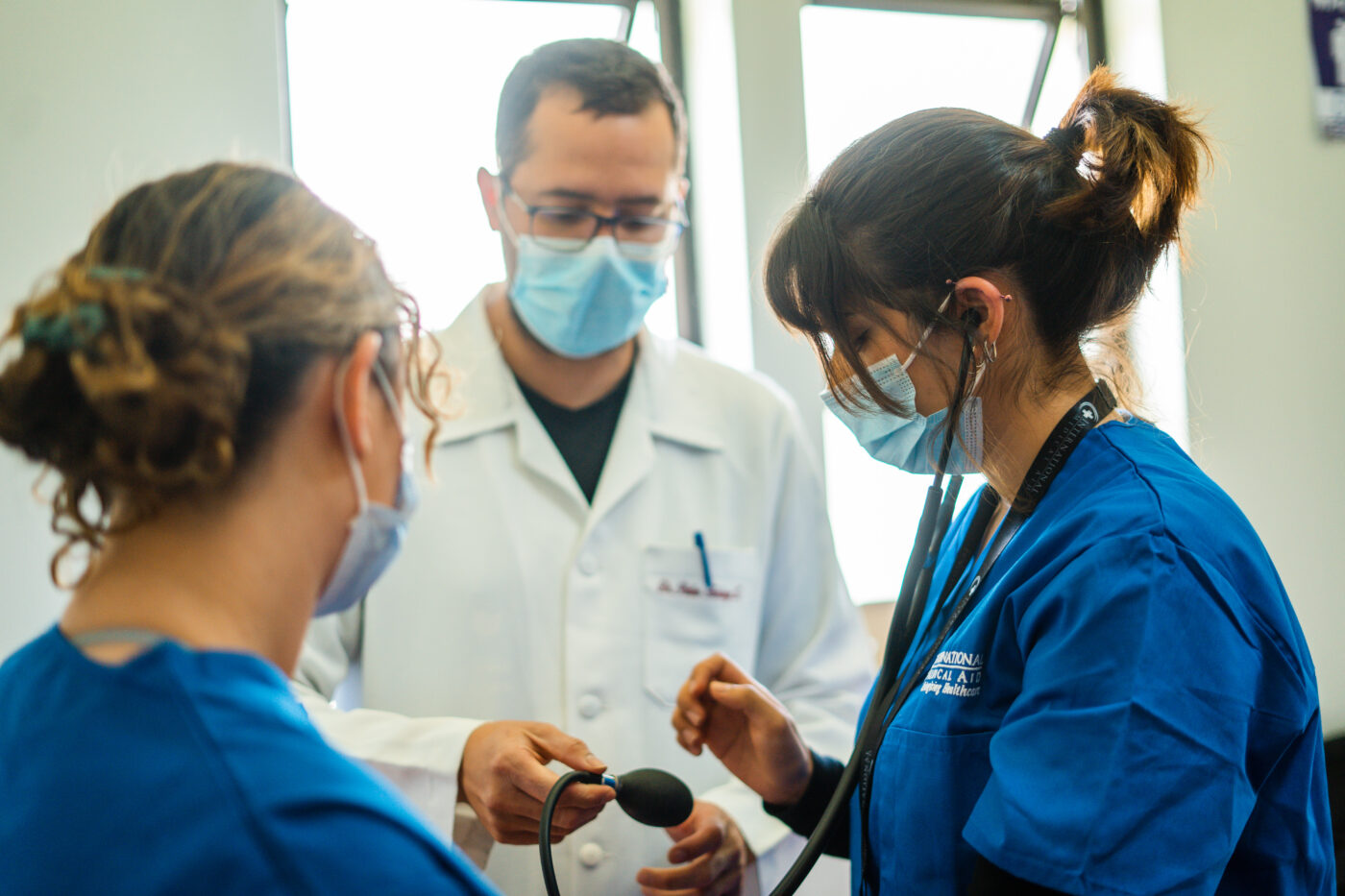In many respects, nurse practitioners and physician assistants share duties. Both can treat patients and perform some of the functions of a doctor, such as prescribing medications and often work for some of the same healthcare systems. However, there are some significant differences to keep in mind.
With the passage of the Affordable Care Act, nurse practitioners and physician assistants saw an increase in their ability to provide care. With a growing senior population, NPs and PAs are playing more of a role in health practices than ever before. Graduates of these programs will have no shortage of career options, with location being one of the significant factors.
Another effect of the Affordable Care Act has been the addition of people to healthcare systems because they could afford insurance. Insured patients are more likely to seek regular medical care. Nurse practitioners and physician assistants can help meet the increased demand.
If you are considering pursuing either path, knowing the differences is a good idea. Understanding these differences will help you make the right decision. Let’s dig into what both professionals do a little more so you can make the right choice.
Nurse Practitioner vs Physician Assistant Educational Requirements
The differences between nurse practitioners and physician assistants start with students entering both professions and following different academic paths. Because the duties of nurse practitioners and physician assistants can vary, there is no one-size solution for all applicants. Students taking either path who intend to specialize will also need to take courses relevant to their specialty.
Nurse practitioners will have at least six years of education with a nursing focus. A current nursing license, CPR certification, and a 3.0 GPA on all coursework are usually the minimum requirements for admission to the Master of Science in Nursing programs. Much focus will be on working independently and cooperatively with a doctor.
Both classroom instruction and clinical units will involve subjects such as pathophysiology, advanced health assessment, and pharmacology. A national certification in the specialty you choose and licensing requirements for your state are necessary. Graduates of nurse practitioner programs will be ready to get into practice in even high-demand settings quickly.
Physician assistant candidates will spend about the same time in school as nurse practitioners but will take more of a medical degree path. Also, as with nurse practitioner students, there will be different requirements based on the school where you apply and the state. Clinical coursework, usually taken during the final year, and classroom and lab classes are also necessary.
New Tracks and Specializations
Recent updates in educational programs show a greater emphasis on patient-centered care and interprofessional collaboration. Accreditation bodies have revised curriculum requirements to include special tracks in geriatric care, mental health, and chronic disease management. These changes ensure that graduates are even better prepared for the evolving challenges in patient care.
What About Accelerated Programs?
A common trend in recent years has been for some schools to allow nurse practitioners and physician assistant students to complete their degrees in less time. The schools offering accelerated programs will provide most classroom courses online, at least for nurse practitioner students. Lab and clinical work will still be completed in person, as usual.
One of the things that people must consider for either program is the time commitment required. For example, nurse practitioner applicants need to still be able to meet the requirements to maintain their nursing license. Academic requirements will need to be carefully balanced against work and personal responsibilities.
Applicants to physician assistant programs will also need to carefully consider the time commitment required for an accelerated program. Because most applicants accepted to these programs usually have jobs with intensive time commitments, these must also be balanced out when taking an accelerated program.
Updated Program Formats
Recent reviews of accelerated programs indicate that while online coursework is prevalent, schools have enhanced support systems (such as flexible scheduling and hybrid clinical placements) to help students balance work and study commitments even more effectively.
Functions of Both Jobs
Nurse practitioners and physician assistants can perform many of the same tasks. With their experience, both professionals can diagnose and treat various conditions. Some of their duties also include prescribing medications and reviewing their patients’ medical histories, possibly making referrals to a physician as necessary.
Both types of professionals will usually work under a physician’s supervision, although the amount of supervision required may vary by state. Each professional’s prescribing authority level may also vary depending on their state. Some patients may be able to use a physician assistant as a primary care provider.
Another advantage for both medical professionals is that they have the option of doing either general practice or a specialty, depending on the demand. A medical professional specializing in specific fields can play a key role in expanding healthcare to underserved populations. The different patient groups that people work within these settings help provide continued experience.
Shifts in Practice Authority
Recent legislative changes have enabled nurse practitioners in about 27 states (plus D.C.) to practice independently without physician oversight. Additionally, several states have revised PA supervision models, shifting toward collaborative agreements that grant experienced PAs increased autonomy. These changes not only reflect evolving healthcare needs but also expand the clinical roles both professionals can play.
Educational Cost
Although the costs for nurse practitioners and physician assistants may seem high, they are still lower than medical school costs. Nurse practitioner educational costs average between $22,500 and $31,500. This cost is a small fraction of the cost of medical school, yet it provides a lot of value for any graduate.
The education for a physician assistant program is higher than that of a nurse practitioner program—most degree programs for this concentration average between $79,941 and $90,659. Although the cost is higher, many graduates consider their future earnings worth the price.
The cost of attending school is a legitimate concern for students. One of the most refreshing things that most students can take comfort from is knowing that financial aid options are available to make pursuing one of these Master’s degree programs more affordable.
Unsubsidized Direct Loans are available for those doing graduate-level academic work. Depending on the servicer for any existing student loans, students may have the option of deferring payment on their current loans. Taking advantage of a deferment option can relieve the financial strain while pursuing your degree.
Scholarships can also be a good idea through businesses or non-profits. An advantage that scholarships offer for students is that they never need to repay the funds. A scholarship can help relieve some of the financial burdens after graduation.
Many students decide to pursue work-study programs. Such programs allow students to work in a similar setting to where they will be employed after graduation. Another advantage of work-study is gaining valuable experience that will be useful on the job.
Current Cost Ranges
Recent data indicate that:
- Nurse Practitioner Programs: MSN program costs now range from about $28,000 to $79,000 total, with an average annual cost near $33,000. Advanced DNP programs at private institutions can exceed $150,000 in total tuition.
- Physician Assistant Programs: The average total tuition is approximately $95,000 for in-state students and around $104,000 for non-residents over a typical 24–27 month program. Some public programs may offer lower rates, while private institutions can be considerably higher.
These figures reflect current trends and should be considered when evaluating the return on investment for these careers.
Insights on Nurse Practitioners and Physician Assistants in 2025
The roles of nurse practitioners and physician assistants continue to evolve alongside changing healthcare demands. In 2025, both professions will be recognized as crucial in addressing healthcare disparities and enhancing patient care, particularly as the population ages and healthcare needs grow more complex.
Shifts in Healthcare Delivery and Policy
New Legislative Developments
In recent years, healthcare legislation has undergone significant changes to improve access to care and reduce the burden on hospitals. Updated policies now grant greater autonomy to nurse practitioners, allowing them to practice independently in more states. Similarly, physician assistants have seen revisions in supervision requirements, enabling more collaborative and flexible care models. These legislative shifts not only improve patient access but also enhance job satisfaction among practitioners.
Evolving Reimbursement Models
Reimbursement structures have been modified to better reflect the value of care NPs and PAs provide. Payers, including private insurers and public programs, now offer compensation models that recognize the expertise and efficiency of these professionals. This change has contributed to a more favorable economic outlook for both career paths, with compensation packages that include performance incentives and expanded benefits.
Economic and Educational Trends
Updated Salary Data and Economic Impact
In 2025, current data indicate that nurse practitioners enjoy median salaries in the mid-to-high $120,000 range. Recent U.S. Bureau of Labor Statistics (BLS) data show that NPs earn an average annual salary of about $128,490 (roughly $61.78 per hour) with a median wage around $129,480 as of May 2023. Physician assistants have experienced similar growth, with the average annual salary now approximately $130,490 (about $62.74 per hour) and a median of around $130,020. The American Academy of PAs (AAPA) also reports a 2023 median base compensation of $127,000, indicating steady upward trends.
Changes in Educational Programs and Accreditation
Educational programs for both NPs and PAs have been updated to emphasize patient-centered care, clinical reasoning, and interprofessional collaboration. New specialized tracks and certificate programs have emerged, ensuring that graduates are well-equipped to handle modern healthcare challenges.
Shifts in Practice and Patient Care
Expanding Roles in Primary and Specialty Care
Both nurse practitioners and physician assistants are increasingly stepping into roles once exclusively occupied by physicians. In primary care settings, NPs manage chronic conditions, provide preventative care, and coordinate follow-up, while PAs are expanding their roles in specialties like cardiology, orthopedics, and emergency medicine.
Enhanced Focus on Patient Relationships and Community Health
With a holistic approach, nurse practitioners have become cornerstones of community health initiatives—designing wellness programs, conducting screenings, and collaborating with local organizations. Physician assistants similarly support community clinics and outreach, particularly in underserved areas.
Regional Trends and Workforce Distribution
Changing Geographic Demand
While traditionally high-paying states like California and New York remain competitive, there is now growing demand in regions that historically had fewer practitioners. States in the Midwest and Southeast are experiencing significant job growth, prompting adjustments in recruitment and training strategies.
Rural and Urban Healthcare Dynamics
In rural settings, NPs and PAs often serve as the primary healthcare providers, filling critical service gaps. In urban areas, they are integral parts of large healthcare systems, working collaboratively to improve overall patient outcomes.
Financial Considerations and Career Sustainability
Evolving Tuition and Financial Support Options
New financial aid packages, flexible payment plans, and scholarship programs have been developed specifically for NP and PA students. These options help balance rising tuition costs with the long-term financial benefits of the careers.
Long-Term Career Outlook and Professional Satisfaction
Both professions report high levels of job satisfaction due to the positive impact they have on patient lives and the flexibility to move into leadership or specialized roles. The robust growth projections—NP employment projected to grow about 40% from 2023 to 2033 and PA employment forecasted to increase by 27–28%—underscore the promising long-term outlook.
Salaries
The salaries that NPs and PAs can earn make the investment in further education worthwhile. Historically, the median salary for nurse practitioners was cited as $113,930 and for physician assistants as $112,260. However, updated data for 2025 show significant increases:
- Nurse Practitioners:
- Average annual salary: $128,490 (approximately $61.78 per hour)
- Median annual wage: $129,480 (as of May 2023)
- Physician Assistants:
- Average annual salary: $130,490 (roughly $62.74 per hour)
- Median pay: $130,020 in 2023
- AAPA reports a median base compensation of $127,000 (a 5.8% increase from 2022)
These updated figures reflect current market adjustments and increased responsibilities for both professions.
Locations with the Greatest Demand and Highest Pay
Nurse practitioners are in high demand in several states, with recent data highlighting the following trends:
- For Nurse Practitioners:
- High-demand states include Alaska, California, Massachusetts, New Jersey, and New York.
- California continues to offer the highest average salary at approximately $133,780, with Alaska following at around $122,880.
- Updated employment figures now show states like Florida and Texas rising in prominence due to growing populations and healthcare needs.
- For Physician Assistants:
- States with high demand include Alaska, Connecticut, Montana, New York, and South Dakota.
- Connecticut leads with an average salary of about $125,610, and Alaska remains competitive at approximately $122,260.
- Additional high-paying states now include Washington (around $123,980), Hawaii ($121,120), and California (approximately $117,230).
[2025 Update – Regional Trends]
Updated Geographic Insights
Recent data also emphasize metropolitan areas such as the New York City metro region, which now employs over 14,500 PAs, and significant NP employment in states like Florida (over 22,000 NPs). These changes reflect shifting demographic trends and healthcare demands across both urban and rural settings.
Is Being a Nurse Practitioner or Physician Assistant the Best Path?
When making your choice, you will need to consider your career goals and the educational commitment required. What you expect your lifetime earnings to be, the costs of your degree, and how long the whole process will take are essential factors. Failing to consider any of these factors will make things more difficult in the long run.
The decision is not easy because there are so many personal dynamics to consider. Internship opportunities can help give you on-the-ground experience that will bring you closer to a choice. One of the advantages of internships is seeing what goes on in the daily life of one of these professionals while you are still in a position to decide which path to pursue.
Many internships are available through non-profits, allowing you to work internationally or in relief settings. Working in a different culture can serve as excellent preparation for communities within the United States with different needs. A relief setting helps provide a solid foundation for working in emergency settings.
Working Independently or Not
Many prospective students wonder whether it is possible to establish a private practice in either program. This question is reasonable and has an answer that might surprise some. Nurse practitioners can operate a private practice if permitted in their state, while physician assistants cannot.
When permitted to operate a practice, a nurse practitioner (NP) can perform a wide range of treatments. NPs usually work with multiple age groups. They may not only diagnose and treat conditions but also perform regular wellness exams.
By definition, a physician assistant works under a physician. Physician assistants are employed by doctors of many specialties and primary care doctors. One area of practice where physician assistants are in high demand is surgical practices.
The Next Steps
Becoming a nurse practitioner or physician assistant is not to be taken lightly. Consider applying to a healthcare internship abroad with International Medical Aid to gain practical, real-world experience to help you determine which career path is best for you!which career path is best for you!





